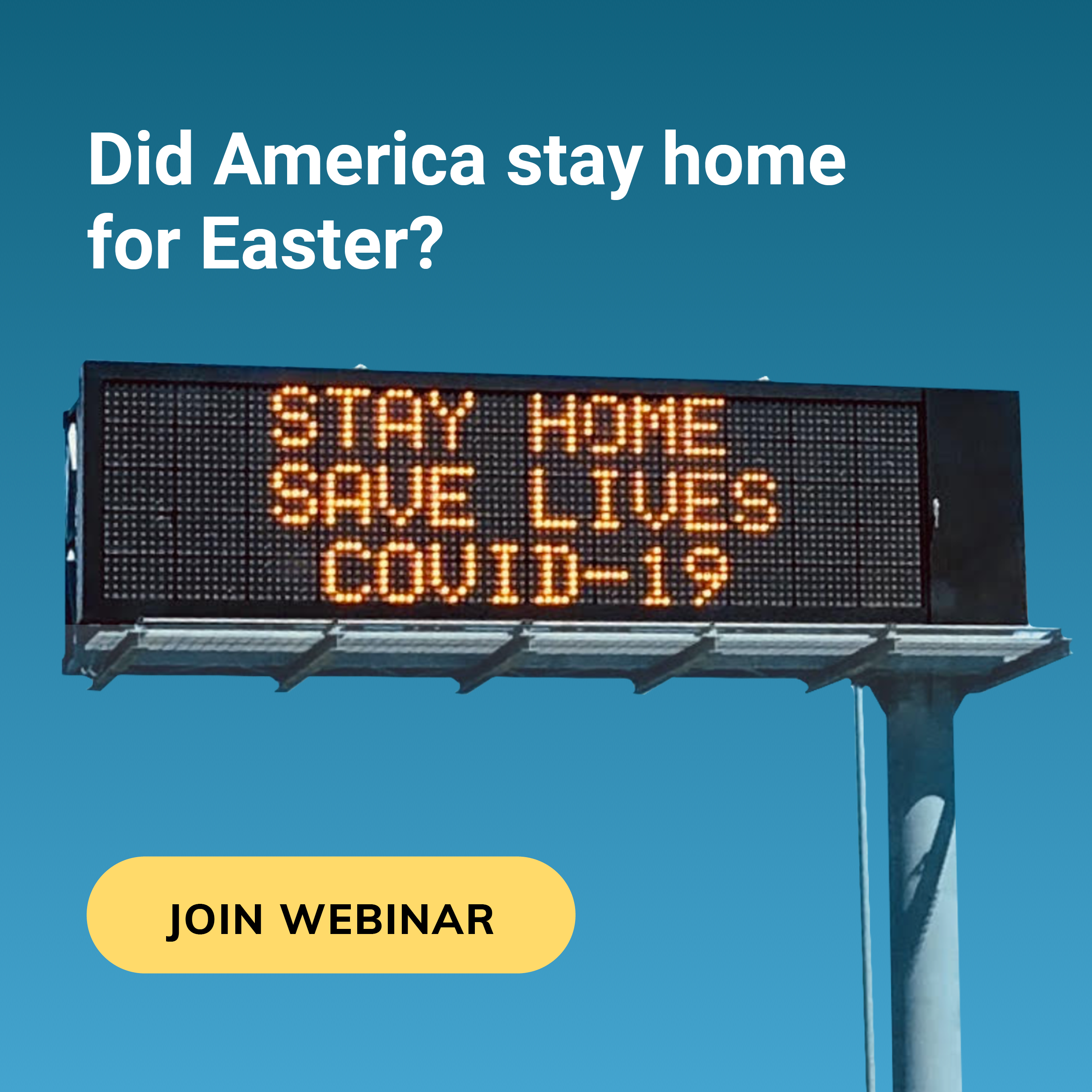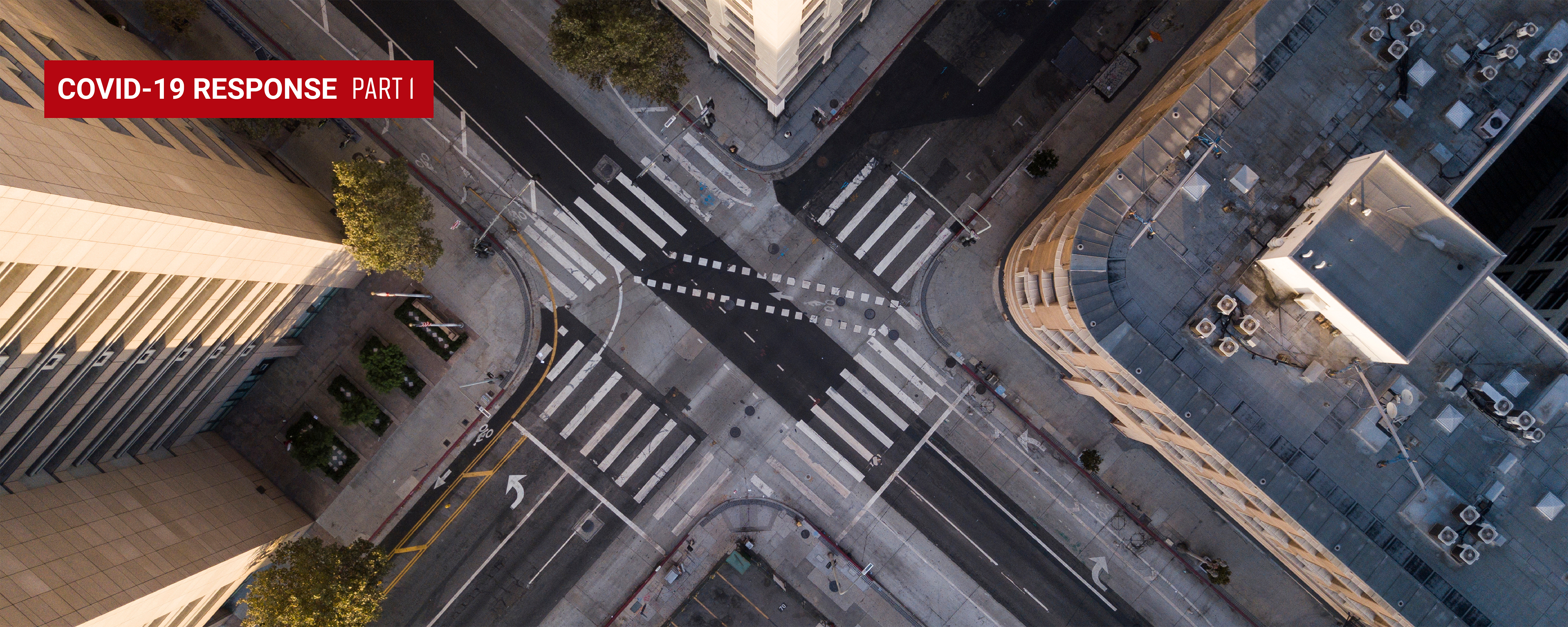
Top 10 Ways Experts Are Measuring COVID-19’s Impact
COVID 19 RESPONSE PART 1
COVID 19 RESPONSE PART 1
COVID 19 RESPONSE PART 1
In this unprecedented moment in history, it feels like everyone wants to understand mobility — and, more importantly, the lack of it. We all want to know where people are traveling, where they aren’t, and how that moves the COVID-19 pandemic across the country.
Those of us in the transportation industry are mining the data to study how the past, present, and future are affected by the pandemic and our responses to it. In this two-part blog series, we’ll explore what StreetLight’s customers and other industry experts are studying about mobility today, what they’re benchmarking, and how they’re using the data to prepare for the gradual transition out of the near-nationwide lockdown.
There Is No “Normal”
Travel patterns are hardly “normal” right now. When data is being used for everything from traffic impacts about a new shopping development to 20-year long-range plans, you don’t want abnormal travel patterns underpinning that work.
And for measuring COVID-19 impacts, surveys take a long time to execute, and people don’t respond well especially during times of stress. And sensors? They are only where they are, which is usually across only a handful of high-volume roads.
Instead, detailed metrics based on LBS and GPS data show how and where people are actually moving at all locations across the country.
What to Study Now
Our customers are using data to continue work that they would normally do using traditional methods like fielding surveys or laying sensors over roadways to make sure they’re not using baseline travel patterns during a time that is very much “not normal”. Others are mining data for clues to the pandemic’s impact.
Here are ten examples of what customers are studying in StreetLight InSight®.
- Vehicle Miles Traveled (VMT) to analyze car activity in your state or individual county. Did Americans “stay home” for Easter is a question many of us are asking right now.
- Intersection turning movement counts to analyze peak hour intersection travel while traditional traffic counts are on hold during shelter-in-place orders.
- Travel speeds to study speeding changes during a time of less road traffic.
- Travel combined with Census data to analyze who is travelling and who is not.
- Rural compared to urban traffic volume, to analyze travel in areas where local stores are shut down and trips to big box stores or metro areas further away might be necessary.
- Origin-Destination data modelling community movements, useful for immediate public health needs to determine where risks of increased cases are arising, and to feed epidemiological forecasting models.
- Home and Work Locations analysis for hospitals to understand where patients are coming from for treatment.
- Home and Work Locations analysis to study whether or not residents are fleeing urban locations for more rural retreats, especially to other states.
- Zone Analytics analyses to identify trip starts and stops for creating effective emergency pickup locations for pharmacies, restaurants, grocery stores, and other essential services.
- VMT data to calibrate the degree of social distancing in epidemiological models, to inform ventilator redeployment models and to optimize timing for lifting restriction measures on schools, transit, and businesses.
Preparing for “Back to Normal”
In our next post we’ll share what important benchmarks planners are capturing, and what they’re analyzing to plan for post-pandemic. We know that travel will never be the same, and we’ve got some powerful ideas for how to prepare.
Subscribe to our blog to receive the second installment, and stay up to date on transportation news and ideas.
In this unprecedented moment in history, it feels like everyone wants to understand mobility — and, more importantly, the lack of it. We all want to know where people are traveling, where they aren’t, and how that moves the COVID-19 pandemic across the country.
Those of us in the transportation industry are mining the data to study how the past, present, and future are affected by the pandemic and our responses to it. In this two-part blog series, we’ll explore what StreetLight’s customers and other industry experts are studying about mobility today, what they’re benchmarking, and how they’re using the data to prepare for the gradual transition out of the near-nationwide lockdown.
There Is No “Normal”
Travel patterns are hardly “normal” right now. When data is being used for everything from traffic impacts about a new shopping development to 20-year long-range plans, you don’t want abnormal travel patterns underpinning that work.
And for measuring COVID-19 impacts, surveys take a long time to execute, and people don’t respond well especially during times of stress. And sensors? They are only where they are, which is usually across only a handful of high-volume roads.
Instead, accurate metrics based on LBS and GPS data show how and where people are actually moving at all locations across the country.
What to Study Now
Our customers are using data to continue work that they would normally do using traditional methods like fielding surveys or laying sensors over roadways to make sure they’re not using baseline travel patterns during a time that is very much “not normal”. Others are mining data for clues to the pandemic’s impact.
Here are ten examples of what customers are studying in StreetLight InSight®.
- Vehicle Miles Traveled (VMT) to analyze car activity in your state or individual county. Did Americans “stay home” for Easter is a question many of us are asking right now.
- Intersection turning movement counts to analyze peak hour intersection travel while traditional traffic counts are on hold during shelter-in-place orders.
- Travel speeds to study speeding changes during a time of less road traffic.
- Travel combined with Census data to analyze who is travelling and who is not.
- Rural compared to urban traffic volume, to analyze travel in areas where local stores are shut down and trips to big box stores or metro areas further away might be necessary.
- Origin-Destination data modelling community movements, useful for immediate public health needs to determine where risks of increased cases are arising, and to feed epidemiological forecasting models.
- Home and Work Locations analysis for hospitals to understand where patients are coming from for treatment.
- Home and Work Locations analysis to study whether or not residents are fleeing urban locations for more rural retreats, especially to other states.
- Zone Analytics analyses to identify trip starts and stops for creating effective emergency pickup locations for pharmacies, restaurants, grocery stores, and other essential services.
- VMT data to calibrate the degree of social distancing in epidemiological models, to inform ventilator redeployment models and to optimize timing for lifting restriction measures on schools, transit, and businesses.
Preparing for “Back to Normal”
In our next post we’ll share what important benchmarks planners are capturing, and what they’re analyzing to plan for post-pandemic. We know that travel will never be the same, and we’ve got some powerful ideas for how to prepare.
Subscribe to our blog to receive the second installment, and stay up to date on transportation news and ideas.

